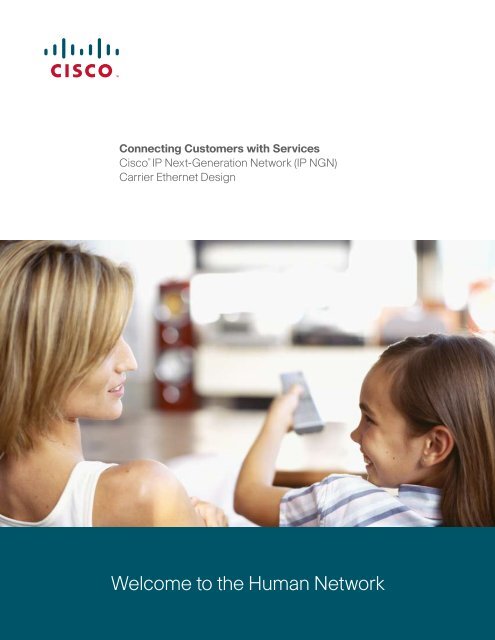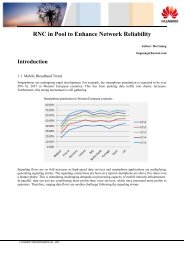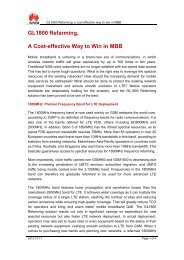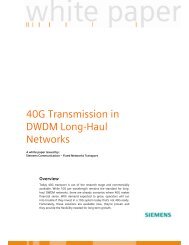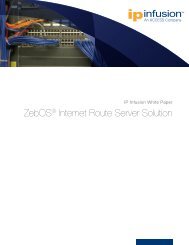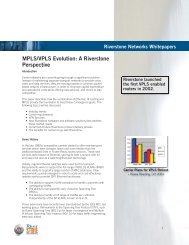Welcome to the Human Network - Light Reading
Welcome to the Human Network - Light Reading
Welcome to the Human Network - Light Reading
Create successful ePaper yourself
Turn your PDF publications into a flip-book with our unique Google optimized e-Paper software.
Connecting Cus<strong>to</strong>mers with Services<br />
Cisco ® IP Next-Generation <strong>Network</strong> (IP NGN)<br />
Carrier E<strong>the</strong>rnet Design<br />
<strong>Welcome</strong> <strong>to</strong> <strong>the</strong> <strong>Human</strong> <strong>Network</strong>
The Connected Life<br />
The Internet is not simply a network of computers; it is a network<br />
of people who connect with each o<strong>the</strong>r when, where, and how<br />
<strong>the</strong>y want. <strong>Network</strong>ing is <strong>the</strong> foundation for all of <strong>the</strong> collaboration<br />
and co-creation that is happening online, and is <strong>the</strong> basis of a<br />
‘Connected Life’ where empowered consumers receive many<br />
services <strong>to</strong> many screens.<br />
As wireline, cable, and mobile service providers strive <strong>to</strong> increase<br />
revenue with new integrated data, voice, and video services, <strong>the</strong>y<br />
must transition from being service access providers <strong>to</strong> ‘experience<br />
providers’ who offer compelling quadruple-play services<br />
available anytime and anywhere. The Cisco ® IP Next-Generation<br />
<strong>Network</strong> (NGN) enables service providers <strong>to</strong> efficiently make this<br />
transition, and thus position <strong>the</strong>mselves <strong>to</strong> deliver a Connected Life<br />
experience <strong>to</strong> an entirely new generation of subscribers (Figure 1).
Watch shows on<br />
demand, answer video<br />
call on TV<br />
Work from<br />
home<br />
Make wait<br />
time productive<br />
Competition, Convergence, and Change<br />
The race is on <strong>to</strong> replace single-purpose networks with all-encompassing IP networks.<br />
The benefits of an IP NGN are well unders<strong>to</strong>od: rapid delivery of rich multimedia services,<br />
increased efficiency, enhanced resource management, and superior service and network<br />
control—a complete business transformation.<br />
IP service delivery has supercharged competition. Cable opera<strong>to</strong>rs are offering voice over<br />
IP (VoIP) and wireline opera<strong>to</strong>rs are countering with video-on-demand (VoD) and IPTV<br />
offerings. Fixed mobile convergence (FMC) is required <strong>to</strong> ensure transparent delivery of<br />
mobile ‘follow-me’ services and revenue sharing across network boundaries. To complicate<br />
things fur<strong>the</strong>r, as all providers are working <strong>the</strong>ir own triple-play or quadruple-play strategies,<br />
new competition is coming from non-facility opera<strong>to</strong>rs who deliver services that will operate<br />
over provider networks. The result is that service providers face constant pressure <strong>to</strong><br />
improve margins, reduce costs, and increase <strong>the</strong>ir average revenue per user (ARPU) with<br />
integrated, higher-value multimedia services.<br />
Flexible infrastructure is essential <strong>to</strong> meet <strong>the</strong>se goals, but many vendor solutions require<br />
experience providers <strong>to</strong> combine a diverse array of network elements that provide<br />
much-needed service intelligence and moni<strong>to</strong>ring capabilities. However, this approach<br />
increases network complexity and drives up <strong>the</strong> cost of deploying services and managing a<br />
multitude of network elements, which is at odds with <strong>the</strong> primary goal of simplifying network<br />
operations and reducing capital costs.<br />
Figure 1. The Connected Life Experience<br />
Conference<br />
face-<strong>to</strong>-face<br />
Find Kid’s GPS<br />
Location on TV<br />
Conduct<br />
Telepresence<br />
meeting<br />
Listen <strong>to</strong> latest tunes<br />
Watch TV on<br />
Train, Program<br />
DVR for <strong>to</strong>night<br />
Schedule a<br />
meeting
One <strong>Network</strong> for Residential and Business Services<br />
Service providers that implement converged multiservice networks can anticipate cost<br />
savings from integrated network operations. As in <strong>the</strong> past, <strong>the</strong> Cisco Carrier E<strong>the</strong>rnet<br />
design supports a smooth integration of business and residential services over a single<br />
architecture that allows for all business service-level agreements (SLAs) <strong>to</strong> be met. Today<br />
this architecture has evolved <strong>to</strong> support more services, increased service flexibility, and<br />
scalability, with carrier-class resiliency and availability.<br />
The Cisco IP NGN Carrier E<strong>the</strong>rnet design (see Figure 3) supports all residential<br />
quadruple-play services and <strong>the</strong> standard Layer 2 Metro E<strong>the</strong>rnet Forum (MEF)<br />
point-<strong>to</strong>-point and multipoint business services plus Layer 3 IP MPLS/Multicast VPNs<br />
for business cus<strong>to</strong>mers. Wholesale services are also supported for both residential and<br />
business cus<strong>to</strong>mers, whereby retail service providers are given interconnectivity <strong>to</strong> <strong>the</strong>ir<br />
subscribers over a tunnel or VPN. In this case, <strong>the</strong> cus<strong>to</strong>mer relationship is held with<br />
<strong>the</strong> retail service provider but <strong>the</strong> access and aggregation network transport is provided<br />
by <strong>the</strong> wholesale provider.<br />
For managed services, <strong>the</strong> Cisco IP NGN Carrier E<strong>the</strong>rnet Design fully integrates<br />
multiservice edge functions in<strong>to</strong> <strong>the</strong> aggregation network, thus optimizing <strong>the</strong> cost and<br />
operational effort required for business VPNs. Managed services can be Layer 2 or Layer<br />
3 VPNs where each VPN supports access through E<strong>the</strong>rnet, DSL, and WiMAX, as well<br />
as redundant cus<strong>to</strong>mer premises equipment (CPE) options. Service providers can now<br />
manage and offer business services with fully differentiated support that complies with<br />
IETF (RFC-2475) and DSL Forum TR-101 requirements.
Optimize Quadruple-Play Services <strong>to</strong> <strong>the</strong> Home<br />
IP cus<strong>to</strong>mers transitioning from cable-based TV or circuit-switched voice have high<br />
expectations of service reliability. Advanced features will not carry <strong>the</strong> market if <strong>the</strong> basics<br />
are missing.<br />
Edge infrastructure must accommodate complex service requirements that surpass<br />
those for best-effort high-speed Internet services. Bundled IP triple-play services require<br />
advanced policy management, service control, and granular quality of service (QoS) <strong>to</strong><br />
meet subscriber expectations. Moreover, wireline providers are beginning <strong>to</strong> implement<br />
quadruple-play networks which support integrated IPTV video, voice, Internet access,<br />
and mobility as a single service package. Mobile service providers prefer <strong>to</strong> deploy <strong>the</strong>ir<br />
third-generation (3G) and WiMAX services, WiFi hotspots, and Hotzones over a single<br />
scalable aggregation network that uses Carrier E<strong>the</strong>rnet for broadband wireless backhaul.<br />
QoS, security, and resiliency requirements for <strong>the</strong>se new residential services<br />
closely approximate those of enterprise cus<strong>to</strong>mers. Service providers need a stable<br />
entertainment-grade network. At <strong>the</strong> network edge <strong>the</strong>y must have a sturdy, flexible,<br />
adaptable platform that can be easily extended across <strong>the</strong> network <strong>to</strong> successfully support<br />
bundled residential services. Figure 2 shows how <strong>the</strong> Cisco IP NGN Carrier E<strong>the</strong>rnet<br />
solution provides flexible integration of quadruple-play services.<br />
Figure 2. The Cisco IP NGN Carrier E<strong>the</strong>rnet solution provides<br />
flexible integration of Quad-Play services.
The Cisco ® IP NGN Carrier E<strong>the</strong>rnet Design<br />
Transform Consumer and Business Services…<br />
The IP NGN Carrier E<strong>the</strong>rnet design (Figure 3) uses key elements of <strong>the</strong> Cisco IP NGN<br />
architecture <strong>to</strong> enable a best-in-class implementation for Carrier E<strong>the</strong>rnet. It is <strong>the</strong> end-<strong>to</strong>-end<br />
transport layer from access, <strong>to</strong> edge aggregation, <strong>to</strong> intelligent services edge, <strong>to</strong> <strong>the</strong><br />
IP/MPLS core. This design incorporates <strong>the</strong> Service Exchange Framework (SEF) network layer<br />
components and provides a flexible, scalable, and reliable network model <strong>to</strong> meet current and<br />
future network service requirements.<br />
One of <strong>the</strong> key principles of <strong>the</strong> Cisco IP NGN Carrier E<strong>the</strong>rnet design is that multiple Layer 2-3<br />
network technologies are used <strong>to</strong> provide optimal flexibility for current and next-generation<br />
service offerings. These technologies and pro<strong>to</strong>cols include native E<strong>the</strong>rnet Virtual LAN (IEEE<br />
802.1q), IEEE 802.1ad, E<strong>the</strong>rnet over MPLS (EoMPLS), Layer 3 Pro<strong>to</strong>col Independent Multicast<br />
(PIM) with Source Specific Multicast (SSM), MPLS VPN, and Hierarchical Virtual Private LAN<br />
Service (H-VPLS). This allows service providers <strong>to</strong> support a broad range of applications while<br />
minimizing <strong>the</strong> capital and operating expenses associated with <strong>the</strong> network infrastructure.<br />
The IP NGN Carrier E<strong>the</strong>rnet design is <strong>the</strong> most scalable approach <strong>to</strong> delivering residential<br />
IPTV because it uses standards-based IP multicast (PIM) <strong>to</strong> deliver broadcast video <strong>to</strong> <strong>the</strong><br />
edge of <strong>the</strong> network. This Layer 3 PIM-SSM <strong>to</strong> <strong>the</strong> edge design optimizes network bandwidth,<br />
and is more reliable than alternative H-VPLS broadcast approaches, which have suboptimal<br />
routing and bandwidth inefficiencies. In addition, PIM is <strong>the</strong> only multicast pro<strong>to</strong>col that has<br />
been proven <strong>to</strong> operate reliably on a large scale, and in particular, Cisco’s PIM implementation<br />
has been optimized for IPTV and provides <strong>the</strong> fast routing convergence and rapid channel<br />
change capabilities expected by business and consumer video service subscribers.<br />
InfoVision Award<br />
Winner 2006<br />
<strong>Network</strong> Intelligence and Innovation<br />
Frost & Sullivan Award<br />
Winner 2007<br />
Carrier E<strong>the</strong>rnet Marketplace
With Flexible and Scalable Provisioning…<br />
The IP NGN Carrier E<strong>the</strong>rnet design provides a platform-independent architecture as well as a<br />
common command-line interface (CLI) and E<strong>the</strong>rnet-based services model across all Carrier<br />
E<strong>the</strong>rnet platforms. This allows for increased service flexibility and scalability across <strong>the</strong> network<br />
whereby multiple point-<strong>to</strong>-point and multipoint Layer 2-3 service types can be provisioned over<br />
<strong>the</strong> same physical port. Because VLANs have only port significance, scaling <strong>the</strong> number of service<br />
instances beyond <strong>the</strong> traditional 4000 limit on a device or network is no longer a problem. This new<br />
flexible provisioning also gives service providers a variety of VLAN translation mappings that help<br />
<strong>to</strong> uniquely track and scale services for <strong>the</strong>ir cus<strong>to</strong>mers. Scalability of <strong>the</strong> aggregation network is<br />
augmented by new 20 Gigabit line cards that support enhanced queuing, high availability, and<br />
Hierarchical Quality of Service (HQoS) functionality.<br />
… combined with Standards-Based OAM<br />
The IP NGN Carrier E<strong>the</strong>rnet design also achieves carrier-class resiliency and troubleshooting<br />
requirements. Standards-based OAM end-<strong>to</strong>-end across <strong>the</strong> access, aggregation, and<br />
distribution components allow service providers <strong>to</strong> manage E<strong>the</strong>rnet connectivity all <strong>the</strong> way<br />
<strong>to</strong> <strong>the</strong> cus<strong>to</strong>mer premises. This includes IEEE 802.1ag for service verification, IEEE 802.3ah for<br />
link-layer troubleshooting, and MEF E-LMI for service status and au<strong>to</strong> provisioning of cus<strong>to</strong>mer<br />
equipment. Cisco is unique in its ability <strong>to</strong> deliver E<strong>the</strong>rnet OAM all <strong>the</strong> way <strong>to</strong> <strong>the</strong> cus<strong>to</strong>mer<br />
premises and <strong>to</strong> link <strong>the</strong> access CPE <strong>to</strong> <strong>the</strong> intelligent Carrier E<strong>the</strong>rnet infrastructure.<br />
The IP NGN Carrier E<strong>the</strong>rnet Design is a highly available solution that supports sub-second<br />
multicast convergence and link res<strong>to</strong>ration across <strong>the</strong> end-<strong>to</strong>-end network. Using Fast Reroute<br />
(FRR) for <strong>the</strong> aggregation and distribution EoMPLS tunnels, 50 millisecond (ms) res<strong>to</strong>ration can<br />
be achieved for link res<strong>to</strong>ration. In <strong>the</strong> event of a node failure, recovery will also occur in less<br />
than one second. Overall, <strong>the</strong> Cisco IP NGN Carrier E<strong>the</strong>rnet design leads <strong>the</strong> industry in both<br />
scalability and resilience.<br />
Figure 3. Cisco IP NGN Carrier E<strong>the</strong>rnet Design
Digital Video and <strong>the</strong> New IPTV Frontier<br />
The Cisco IP NGN Carrier E<strong>the</strong>rnet design<br />
supports numerous features for advanced video<br />
service delivery by using state-of-<strong>the</strong>-art<br />
multicast techniques. With this design, an IP<br />
NGN can also manage oversubscription while<br />
incorporating major innovations that enhance<br />
<strong>the</strong> subscriber experience with IPTV.<br />
Innovating <strong>to</strong> Preserve <strong>the</strong> Visual Experience<br />
Video service delivery can be enhanced by employing Layer 3<br />
intelligence in <strong>the</strong> aggregation network . As part of <strong>the</strong> Cisco IP NGN<br />
Carrier E<strong>the</strong>rnet design, <strong>the</strong> Cisco 7600 Series Routers support<br />
Cisco Visual Quality Experience (VQE) technology, a combination of<br />
innovations that resolve many perplexing challenges <strong>to</strong> successful<br />
IPTV delivery. Initially available as a network appliance with<br />
functionality that integrates in<strong>to</strong> <strong>the</strong> Cisco 7600 Series, <strong>the</strong> Cisco<br />
VQE allows wireline providers <strong>to</strong> match baseline performance<br />
expectations for picture quality and channel-change times that<br />
are inherently difficult <strong>to</strong> achieve on copper-based transport while<br />
maintaining <strong>the</strong> overall viewing experience.
Cisco VQE offers service providers <strong>the</strong> following benefits:<br />
Video Error Repair<br />
Cisco VQE enables providers <strong>to</strong> precondition DSL lines for advanced video services<br />
such as IPTV by detecting and repairing packet loss on degraded copper lines. With<br />
this technology, a set-<strong>to</strong>p box (STB) detecting packet loss, requests a retransmission<br />
while holding <strong>the</strong> video sequence in queue. The Cisco VQE technology au<strong>to</strong>matically<br />
repairs <strong>the</strong> error by transmitting <strong>the</strong> missing packet, which is re-sequenced by <strong>the</strong> STB<br />
without interruption. The entire error repair cycle takes place in less than 100 ms, and is<br />
imperceptible <strong>to</strong> <strong>the</strong> viewer.<br />
Rapid Channel Change<br />
A transparent channel-change experience is a critical determinant of <strong>the</strong> subscriber’s<br />
visual experience. Cisco VQE standard-based fast channel-change technology<br />
reduces channel-change times from several seconds <strong>to</strong> less than 1 second by initiating<br />
video streams in less than 100 ms after a request is made. This technology works in<br />
conjunction with STBs <strong>to</strong> detect and accelerate channel-change requests. The result is<br />
<strong>to</strong>tally transparent <strong>to</strong> <strong>the</strong> viewer, who sees an uninterrupted channel change followed by<br />
successive video motion.<br />
Video Connection Admission Control (CAC)<br />
Occasional peaks in traffic usage can dramatically affect video quality. A single incremental<br />
access request for high-demand broadcast channels or VoD, if permitted, can disrupt<br />
<strong>the</strong> viewing experience for that entire community of viewers because network bandwidth<br />
becomes oversubscribed. Comprehensive and reliable admission control can help<br />
preserve <strong>the</strong> viewing experience for all subscribers.<br />
By employing in-path utilization analysis that quickly and accurately tracks network<br />
bandwidth, Cisco Video CAC prevents initiation of a request when it is determined that <strong>the</strong><br />
network lacks <strong>the</strong> capacity <strong>to</strong> carry <strong>the</strong> video stream <strong>to</strong> a subscriber. Subscriber notification<br />
is provided <strong>to</strong> gracefully delay a service request, and simultaneously preserve <strong>the</strong> visual<br />
experience for all o<strong>the</strong>r subscribers. A complementary off-path process prevents a video<br />
on-demand stream from being sent if <strong>the</strong> access link <strong>to</strong> <strong>the</strong> subscriber lacks <strong>the</strong> capacity<br />
<strong>to</strong> carry <strong>the</strong> stream. In this approach, <strong>the</strong> VoD server communicates with <strong>the</strong> Cisco BPM<br />
(policy server), which keeps track of <strong>the</strong> subscriber access links.<br />
Video Quality-Moni<strong>to</strong>ring Module<br />
The Cisco <strong>Network</strong> Analysis Module moni<strong>to</strong>rs video streams in real time and sends<br />
proactive alerts <strong>to</strong> providers if picture quality is degraded, enabling <strong>the</strong>m <strong>to</strong> determine <strong>the</strong><br />
cause of <strong>the</strong> degradation and correct it before call centers are overwhelmed.<br />
Employing Layer 3 in <strong>the</strong> video distribution network takes advantage of Pro<strong>to</strong>col<br />
Independent Multicast (PIM) with Source Specific Multicast (SSM) and Interior Gateway<br />
Pro<strong>to</strong>col (IGP) enhancements that enable fast network-level convergence for greater<br />
network efficiency and scale. More importantly, <strong>the</strong>se Layer 3 fast convergence techniques<br />
provide consistent subsecond network and application recovery for all failure modes,<br />
fur<strong>the</strong>r ensuring <strong>the</strong> visual experience for video subscribers.
Enhancing <strong>the</strong><br />
User Experience...
Industry’s First Subscriber- and<br />
Application-Driven Solution<br />
The close coupling of subscriber-aware and application-aware functions enabled by <strong>the</strong><br />
Cisco Intelligent Services Gateway (ISG) and Cisco Service Control Engine (SCE) allows<br />
service providers <strong>to</strong> dramatically enhance <strong>the</strong> quality of experience for triple-play services.<br />
Traditional subscriber management systems can enhance <strong>the</strong> user experience through<br />
pull-based techniques such as parental control, self-care, or turbo-but<strong>to</strong>ns that accelerate<br />
performance for a specific application in a specific timeframe based on a subscriber<br />
request. The integration of <strong>the</strong> Cisco ISG and Cisco SCE enables new push-based network<br />
features that are application-driven, allowing subscribers <strong>to</strong> select an application or set of<br />
applications for au<strong>to</strong>matic prioritization based on individual needs and preferences.<br />
Personalized Subscriber Management<br />
As service providers transform in<strong>to</strong> experience providers, <strong>the</strong>y must sufficiently control<br />
network access in order <strong>to</strong> identify, in real time, subscribers and <strong>the</strong> services <strong>the</strong>y use. To<br />
do this requires a clear understanding of who subscribers are, what services <strong>the</strong>y are using,<br />
and what policies govern each account.<br />
Cisco Service Control Engine (SCE)<br />
This carrier-grade network element inspects packets within each traffic flow, making <strong>the</strong><br />
network application-aware and subscriber-aware. The Cisco SCE communicates with a policy<br />
manager <strong>to</strong> differentiate between different types of traffic, prioritizes traffic flows, and <strong>the</strong>reby<br />
optimizes <strong>the</strong> network <strong>to</strong> meet specific Service Level Agreements (SLAs).<br />
Cisco Intelligent Services Gateway (ISG)<br />
This function, available in intelligent edge routers such as <strong>the</strong> Cisco 7600 and 10000 Series<br />
platforms, au<strong>to</strong>matically detects when users are accessing <strong>the</strong> network and determines<br />
both <strong>the</strong> type of services each user wishes <strong>to</strong> access and <strong>the</strong> type of device that is being<br />
used. The Cisco ISG has <strong>the</strong> intelligence <strong>to</strong> manage access for both IMS and o<strong>the</strong>r<br />
non-SIP-based services, by many different types of devices.<br />
Capabilities such as multidimensional identity simplify au<strong>the</strong>ntication, permitting<br />
sign-on from any access point <strong>to</strong> a multitude of services. Subscriber profiles become<br />
extensible based upon usage, enabling high-quality, tailored service delivery. Integrated<br />
local policy management allows service providers <strong>to</strong> dynamically apply QoS on a<br />
per-subscriber basis. By locally administering policy for well-defined services, <strong>the</strong><br />
Cisco 7600 and 10000 Series platforms empower experience providers <strong>to</strong> dynamically<br />
personalize services and address subscriber-specific preferences that can enhance<br />
overall application performance.<br />
Policy Management<br />
Cisco policy management uses intelligence in <strong>the</strong> edge routers for au<strong>to</strong>matic detection when<br />
users access <strong>the</strong> network and allows for <strong>the</strong> option of using au<strong>the</strong>ntication, authorization, and<br />
accounting (AAA) servers for operational duties. Cisco allows <strong>the</strong> network or a centralized policy<br />
management system <strong>to</strong> detect policy triggers or make policy decisions.
Optimized Mobility
Mobile wireless networks are poised <strong>to</strong> become a primary vehicle for a wide<br />
variety of communications applications. Data is becoming a major force<br />
behind <strong>the</strong> mobile opera<strong>to</strong>rs’ efforts <strong>to</strong> significantly increase ARPU. Service<br />
providers are focusing on building a network that is capable of delivering<br />
a host of real-time multimedia applications in addition <strong>to</strong> supporting<br />
business-class data application and services.<br />
Extending <strong>the</strong> capabilities of <strong>the</strong> Cisco Service Exchange Framework, <strong>the</strong> Cisco IP NGN<br />
Carrier E<strong>the</strong>rnet design supports service access control, deep packet inspection, Mobile<br />
IP, security, and packet gateways for each of <strong>the</strong> major radio technologies. Packet gateway<br />
options include <strong>the</strong> Cisco Packet Data Serving Node (PDSN) for Code Division Multiple<br />
Access (CDMA), Cisco Gateway GPRS Support Node (GGSN) for Global System for Mobile<br />
Communications/Universal Mobile Telecommunications Service (GSM/UMTS), and IP<br />
Transfer Point (ITP) for offloading SS7 signaling on<strong>to</strong> IP networks. Cisco is also a leader in<br />
<strong>the</strong> development of IEEE 802.x technology <strong>to</strong> support public wireless LAN installations and<br />
Wi-Fi municipal mesh deployments in <strong>the</strong> unlicensed bands. The latter is an exciting new<br />
area that promises very high data rates in metropolitan areas using unlicensed spectrum.<br />
The next-generation mobile networks will make extensive use of both licensed and<br />
unlicensed wireless technologies. Unlicensed radio technologies provide very high<br />
performance over a limited area, whereas licensed radio technologies provide ubiqui<strong>to</strong>us<br />
connectivity across <strong>the</strong> wide area but offer less performance than is generally available from<br />
an unlicensed service. Mobile IP is <strong>the</strong> glue that can bind <strong>the</strong>m <strong>to</strong>ge<strong>the</strong>r in<strong>to</strong> a transparent<br />
service offering.<br />
Metropolitan Wi-Fi Mesh <strong>Network</strong>ing<br />
The Cisco IP NGN Carrier E<strong>the</strong>rnet design is unique in its industry-leading ability <strong>to</strong><br />
converge services over E<strong>the</strong>rnet, including metropolitan Wi-Fi mesh networking. The<br />
Wireless Services Module (WiSM), which is integrated in<strong>to</strong> <strong>the</strong> Cisco 7600 Series, offers<br />
integrated Wi-Fi access-point aggregation, enabling providers <strong>to</strong> scale and manage<br />
metropolitan Wi-Fi mesh networks. The WiSM supports <strong>Light</strong>weight Access Point<br />
Pro<strong>to</strong>col (LWAPP) while providing extensive integrated security capabilities such as Wi-Fi<br />
Protected Access (WPA2) and various types of <strong>the</strong> Extensible Au<strong>the</strong>ntication Pro<strong>to</strong>col<br />
(EAP), including Protected EAP (PEAP).<br />
The module also improves wireless security through rogue access-point detection and<br />
containment and by supporting a wireless intrusion prevention system (IPS) <strong>to</strong> provide<br />
consistent security-policy enforcement across <strong>the</strong> entire fixed and wireless network.<br />
Providers can use <strong>the</strong> WiSM <strong>to</strong> enable convergence of Wi-Fi, mobile (IP Radio Access<br />
<strong>Network</strong>, PDSN, and GGSN), and fixed (Layer 2 and 3) networks for flexible advanced<br />
service aggregation.<br />
PDSN and GGSN Integration<br />
The PDSN and GGSN packet gateway options allow service providers <strong>to</strong> reduce <strong>the</strong> costs<br />
associated with deploying and operating mobile wireless networks by consolidating<br />
<strong>the</strong> switched systems required <strong>to</strong> converge applications across multiple transport<br />
technologies (SONET, time-division multiplexing [TDM], ATM, etc.) <strong>to</strong> a single E<strong>the</strong>rnet and<br />
IP/MPLS network This integration allows providers <strong>to</strong> use lower-cost alternative access<br />
technologies such as broadband E<strong>the</strong>rnet, DSL, and IP wireless radio based on <strong>the</strong> best<br />
available cost on a market-by-market basis.<br />
Cisco IP NGN Carrier E<strong>the</strong>rnet design supports integration with PDSN and GGSN<br />
networks, enabling providers <strong>to</strong> fur<strong>the</strong>r reduce costs by using IP networks <strong>to</strong> backhaul<br />
wireline and mobile traffic, avoiding <strong>the</strong> need <strong>to</strong> build out additional capacity of costly<br />
TDM networks.
Figure 4. The Cisco IP NGN Carrier<br />
E<strong>the</strong>rnet Design Product Portfolio<br />
E<strong>the</strong>rnet and IP/MPLS<br />
Cisco<br />
12000/XR 12000<br />
Cisco 10000<br />
Cisco Catalyst<br />
3750 Metro<br />
Cisco Integrated<br />
Services Router<br />
Cisco<br />
Catalyst 4500<br />
Cisco<br />
Catalyst 6500<br />
Cisco CRS-1<br />
Cisco 7600<br />
Cisco 7200/7300<br />
Cisco ME 3400<br />
Cisco ME 4924<br />
Cisco ME 6524<br />
E<strong>the</strong>rnet/SONET/SDH<br />
E<strong>the</strong>rnet/DWDM<br />
Cisco ONS 15600<br />
Cisco ONS 15454<br />
Cisco ONS 15300
<strong>Welcome</strong> <strong>to</strong> <strong>the</strong> <strong>Human</strong> <strong>Network</strong>...<br />
Realizing <strong>the</strong> Promise of <strong>the</strong> IP NGN<br />
The potential of <strong>the</strong> Internet is being fulfilled by more than <strong>the</strong> physical network alone.<br />
Today, it is about <strong>the</strong> power of <strong>the</strong> human network where end users are creating<br />
collaborative Websites, mixing content, and deciding how companies will interact with <strong>the</strong>m.<br />
Today’s consumers demand a unified, personalized, high-performance experience for data,<br />
voice, and video services at home, at work, and on <strong>the</strong> move—and <strong>the</strong> Cisco IP NGN is <strong>the</strong><br />
fundamental platform that enables <strong>the</strong>se rich Connected Life experiences.<br />
This means service providers can now apply Cisco IP NGN and partner technologies<br />
<strong>to</strong> blend and integrate data, voice, and video services <strong>to</strong> create unique ‘connected<br />
experiences’ for <strong>the</strong>ir residential and business consumers, and in doing so, transform from<br />
being a service provider <strong>to</strong> an experience provider.<br />
With <strong>the</strong> Cisco IP NGN Carrier E<strong>the</strong>rnet design, residential and business consumers are<br />
able <strong>to</strong> personalize and define <strong>the</strong>ir connected lives using <strong>the</strong> next-generation services that<br />
experience providers deliver. With ubiqui<strong>to</strong>us mobility for home- and office-based services,<br />
consumers are never out of <strong>to</strong>uch with friends, family, or business associates; nor are <strong>the</strong>y<br />
ever disconnected from <strong>the</strong>ir business networks and <strong>to</strong>ols or unable <strong>to</strong> view and listen <strong>to</strong><br />
<strong>the</strong>ir preferred entertainment. This is <strong>the</strong> Connected Life delivered by experience providers<br />
and enabled by Cisco IP NGN technologies and solutions.<br />
Figure 5. Experiences on <strong>the</strong> <strong>Human</strong> <strong>Network</strong><br />
Integrated service delivery requires a network infrastructure that can converge functions<br />
and decrease costs so that providers can successfully—and profitably—deliver on <strong>the</strong><br />
promise of quadruple-play services. The Cisco IP NGN Carrier E<strong>the</strong>rnet design offers<br />
service providers <strong>the</strong> most extensive set of configurable options <strong>to</strong> meet evolving needs<br />
while enabling unsurpassed cost savings.<br />
An end-<strong>to</strong>-end Cisco IP NGN extends from <strong>the</strong> Cisco 7600 Series at <strong>the</strong> edge <strong>to</strong> <strong>the</strong> Cisco<br />
CRS-1 Carrier Routing System at <strong>the</strong> network core. Scalable end-<strong>to</strong>-end multicast, QoS,<br />
management of network oversubscription, and Layer 2 and Layer 3 flexibility with E<strong>the</strong>rnet<br />
OAM all work <strong>to</strong>ge<strong>the</strong>r <strong>to</strong> form a cohesive solution that delivers service intelligence and<br />
unsurpassed performance.
Americas Headquarters<br />
Cisco Systems, Inc.<br />
170 West Tasman Drive<br />
San Jose, CA 95134-1706<br />
USA<br />
www.cisco.com<br />
Tel: 408 526-4000<br />
800 553-NETS (6387)<br />
Fax: 408 527-0883<br />
Asia Pacific Headquarters<br />
Cisco Systems, Inc.<br />
168 Robinson Road<br />
#28-01 Capital Tower<br />
Singapore 068912<br />
www.cisco.com<br />
Tel: +65 6317 7777<br />
Fax: +65 6317 7799<br />
Europe Headquarters<br />
Cisco Systems International BV<br />
Haarlerbergpark<br />
Haarlerbergweg 13-19<br />
1101 CH Amsterdam<br />
The Ne<strong>the</strong>rlands<br />
www-europe.cisco.com<br />
Tel: +31 0 800 020 0791<br />
Fax: +31 0 20 357 1100<br />
Cisco has more than 200 offices worldwide. Addresses, phone numbers, and fax numbers are listed on <strong>the</strong> Cisco Website at www.cisco.com/go/offices.<br />
©2007 Cisco Systems, Inc. All rights reserved. CCVP, <strong>the</strong> Cisco logo, and <strong>the</strong> Cisco Square Bridge logo are trademarks of Cisco Systems, Inc.; Changing <strong>the</strong> Way We Work, Live, Play, and Learn is a service mark of<br />
Cisco Systems, Inc.; and Access Registrar, Aironet, BPX, Catalyst, CCDA, CCDP, CCIE, CCIP, CCNA, CCNP, CCSP, Cisco, <strong>the</strong> Cisco Certified Internetwork Expert logo, Cisco IOS, Cisco Press, Cisco Systems, Cisco Systems<br />
Capital, <strong>the</strong> Cisco Systems logo, Cisco Unity, Enterprise/Solver, E<strong>the</strong>rChannel, E<strong>the</strong>rFast, E<strong>the</strong>rSwitch, Fast Step, Follow Me Browsing, FormShare, GigaDrive, HomeLink, Internet Quotient, IOS, iPhone, IP/TV, iQ Expertise, <strong>the</strong><br />
iQ logo, iQ Net Readiness Scorecard, iQuick Study, <strong>Light</strong>Stream, Linksys, MeetingPlace, MGX, <strong>Network</strong>ing Academy, <strong>Network</strong> Registrar, Packet, PIX, ProConnect, ScriptShare, SMARTnet, StackWise, The Fastest Way <strong>to</strong><br />
Increase Your Internet Quotient, and TransPath are registered trademarks of Cisco Systems, Inc. and/or its affiliates in <strong>the</strong> United States and certain o<strong>the</strong>r countries. 10586-0807/Cisco<br />
All o<strong>the</strong>r trademarks mentioned in this document or Website are <strong>the</strong> property of <strong>the</strong>ir respective owners. The use of <strong>the</strong> word partner does not imply a partnership relationship between Cisco and any o<strong>the</strong>r company. (0705R)


